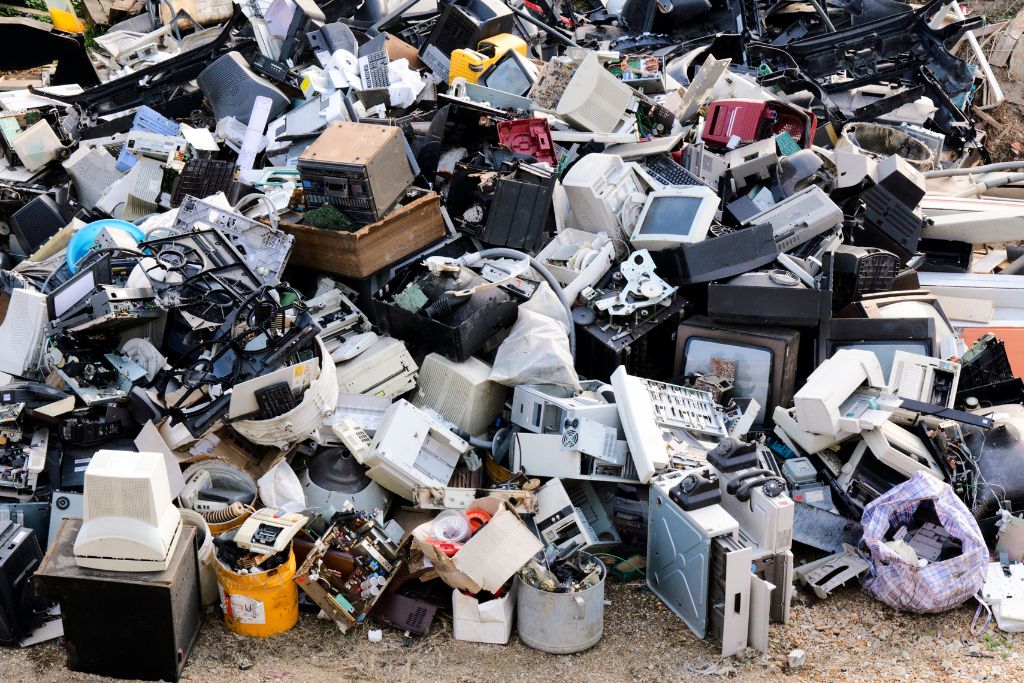E-waste recycling is the process of extracting valuable materials after shredding the e-waste into tiny pieces that could be reused in a new electronic appliance. Unfortunately, low global recycling rates and other challenges contribute to massive quantities of e-waste accumulating in landfills around the world, the environmental impact of which cannot be ignored.
—
Electronic waste, or e-waste, is considered a “time bomb” in the present globalised world. The term comprises electronic devices that are unwanted, not working, or have reached the end of their “useful life”.
The annual production rate of e-waste is increasing gradually. China is the largest e-waste producer, followed by the US which has a recycling rate of just 17.4%.
The Rise of E-Waste
The fundamental cause of the fastest increase in e-waste output is people’s insatiable need to own technological devices. The United Nations came up with the phrase “e-waste tsunami” to describe the critical situation we find ourselves in.
Although the proliferation of electronic devices is one component that fuels the issue, these same tools have the potential to be crucial in finding a solution. If we live in a world that is both more digital and more connected, we will be able to advance more quickly toward the Sustainable Development Goals (SDGs) of the United Nations. Additionally, it will enable developing countries to benefit from chances that have never been presented to them.
Key Facts About E-Waste
By the year 2021, the total amount of manufactured electronic waste was 57.4 million tonnes. Additionally, as the years go by, the total is increasing at a rate of roughly 2 Mt per year, on average. Experts estimate that there will be a total of 347 metric tons of non-recycled e-waste globally by the end of the current year.
Only 17.4% of the e-waste is properly collected and recycled, alarming data that clearly shows that a major portion of e-waste is thrown into dumps without considering any recycling procedure and detrimental effects on the planet’s ecology.
You might also like: What is E-Waste Recycling and How Is it Done?
The Environmental Impact of E-Waste
Soil contamination Inspection suggests that there is a possibility that the soil in the region surrounding of e-waste could get contaminated because of large levels of lead and mercury in those materials.
According to the Geneva Environment Network, which analysed the environmental impact of e-waste, elements and materials used in the manufacturing of electronic devices are incredibly harmful to our planet. As soon as they are dumped into a landfill, especially in the warmer months of the year, they are just left to soak into the ground. Years may pass throughout this process.
One of the major negative effects on the environment is caused by heating e-waste which results in the discharge of toxic compounds such as lead, cadmium and beryllium into the air. After that, there is a chance for the poisonous substances to seep into the groundwater, where they may influence both aquatic and terrestrial species.
When the e-waste comes intact with landfills, the surrounding soil gets contaminated with hazardous substances like mercury, cadmium, and lead which leads to several diseases. According to the World Health Organization, several adverse health effects are caused by exposure to e-waste like negative birth outcomes like premature birth, changes in lung functions, and respiratory issues. And these challenges are emerging day by day. Furthermore, the proper collection and recycling of e-waste can result in protecting and maintaining the environment and human health.
Final Thoughts
The issue of e-waste is significant globally, even so, it is not as frequently mentioned. It causes the acceleration of climate change, results in the waste of significant resources, and endangers both the environment’s and humans’ health.
Every one of us might be able to find a solution to this issue. The choices we make have a significant impact on the natural world if we choose to live in a way that is less damaging to the environment. We must make sure that every piece of used electronic equipment is recycled or otherwise disposed of properly before we can move on. In a developed country, everyone has access to facilities that will recycle their old electronic equipment. In developing nations, however, this access is restricted.
Developed countries can help other developing ones with recycling in the following different ways:
- Implementing trade policies that encourage the use of recycled materials.
- Through collaborative initiatives, developed countries can join hands with developing ones to establish approaches to address the challenges of recycling like a global recycling network.
The majority of the waste generated by the global electronic industries consists of the smallest items. Everyone can make a difference by making simple, more sustainable changes, such as opting for an eco-friendly phone cover rather than one made of plastic, or using a sustainable electric toothbrush with recyclable heads. These are just two examples that can help you lessen your environmental impact. The only issue for which we can come up with a solution without the help of either commercial businesses or governmental organisations is the removal of e-waste. So, let’s all contribute in some way.
You might also like: What Is the Right to Repair Movement?


















